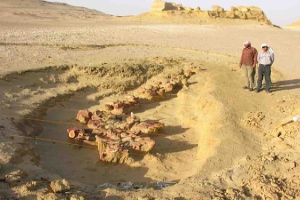 Credit: P.D. Gingerich, Univ. Michigan.This past week, fossil whales made it into the newswires again. This time, the news wasn't strictly about a new discovery or new insight -- instead, it has to with accusations of vandalism.
Credit: P.D. Gingerich, Univ. Michigan.This past week, fossil whales made it into the newswires again. This time, the news wasn't strictly about a new discovery or new insight -- instead, it has to with accusations of vandalism.
About 150 km south of Cairo lies a huge expanse of desert, called Wadi Al-Hitan. Unlike the classic desert of dunes upon dunes, Wadi Hitan preserves large exposures of rocks from the late Eocene through the early Oligocene (~40-30 million years ago). The first fossil whales-- from beasts like the large, eel-like Basilosaurus, which reached over 50 feet long -- were found in 1905. For the subsequent 100 years, paleontologists have recovered a trove of other marine mammals including severalspecies of fossil whales (archaeocetes) and sea cows. Rocks from higher up in the Wadi Al-Hitan sequence, near the Qasr El Saga temple, have also produced some of the oldest primates in the world. Over 390 whale skeletons have been found in the area, earning it the nickname "Valley of the Whales." Detailed studies of the rocks in which the fossil whales are embedded indicate a lagoon-like environment when the whales lived, and, possibly, a calving ground for these early whales.
Aside from the supreme paleontological importance of the site, the Wadi Hitan is also full of important archeological remains as well. Together, this led UNESCO to recognize the area as a Natural World Heritage Site, a rare accolade for a fossil site. One of the problems with designating such places (especially in a remote area) is ensuring resource protection, not only from the elements but also human activity. Enter Egyptian officials, who last week formally accused Belgian diplomats of driving 4WD vehicles over key fossil sites this summer. Egyptian officials estimate that the alleged vandalism caused USD 325,000 worth of damage, while Belgian officials
deny the charges.
Even with UNSECO's name, true protection is a matter of money (park rangers and guards), and also vigilance -- and getting both is as hard in Egypt as it is in the US. As a whale paleontologist, the disregard for their fossil remains infuriates me, but as a citizen, I find wanton damage to any heritage site shameful. How would you feel if someone dynamited the top of Half Dome in Yosemite, or spray-painted George Washington's nose at Mt. Rushmore? Like one of the Egyptian officials said, "The financial value doesn't really matter. What matters is the historical value."
![]() Nick Pyenson is a PhD candidate at the University of California, Berkeley, in the department of integrative biology and the museum of paleontology.
Nick Pyenson is a PhD candidate at the University of California, Berkeley, in the department of integrative biology and the museum of paleontology.
